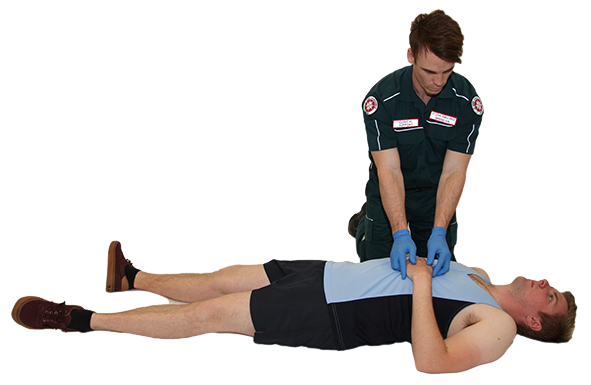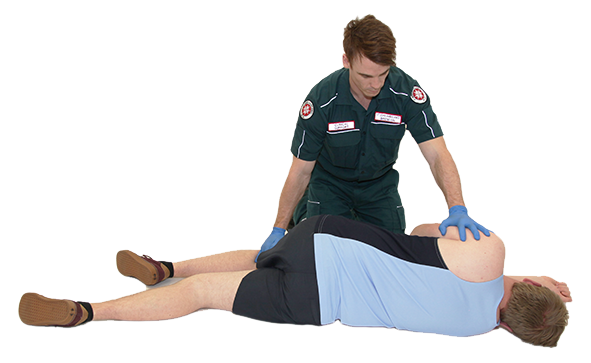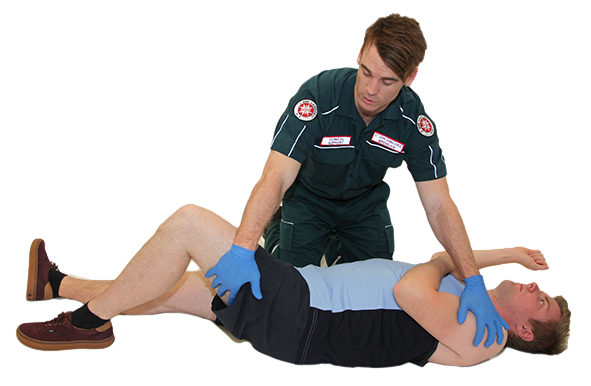
- Positioning of unconscious patients with no suspected spinal injury to provide airway management.
- Patients in spinal considerations. Use the modified Lateral Trauma Position for these patients
- An unconscious patient, when left supine, is at risk of hypoxia and aspiration due to the relaxation of the airway structures and secretions obstructing the airway.
- The lateral or recovery position allows for drainage of any secretions and assists to maintain the patient's airway.
- Ensure usage of all relevant PPE.
- Pregnant females should be placed in the Left Lateral Tilt (LLT) for basic airway management. If patient in cardiac arrest, use Relief of Aortocaval Compression.
- The modified Trauma Lateral Position is for patients in spinal immobilisation whose airway cannot be managed with BLS/ALS intervention as a last resort
Key Principles
- The patient should be in as near a true lateral position as possible to allow free drainage of fluid and avoid airway obstruction.
- The position should be stable.
- Avoid any pressure on the patient's chest that impairs breathing.
- It should be possible to turn the patient onto their side and return to supine easily and safely, ensuring all consideration is given to the possibility of cervical spine injury.
- The position should allow good observation of and easy access to the patient's airway.
- The position itself should not cause any injury of the patient.
Procedure
- Kneel beside the patient, remove any spectacles and watches and check pockets for bulky items.[1]
- Place arm nearest to you at a right angle to the patient’s body with arm bent into the position it falls. Do not force arm into position.[2]
- Bring the arm furthest away from you across the patient’s chest and hold the back of the hand against their nearest cheek.[3]
- With your other hand, grasp the leg furthest from you just above the knee and pull it up keeping the foot on the ground.[4]
- Keep the patient’s hand pressed against the cheek and pull on the raised leg to roll the patient towards you onto their side.[5]
- Roll the patient gently towards you keeping your knees clear from their body and constantly supporting the head.[6]
- Adjust the patient’s upper leg so that both the hip and knee are bent at right angles. Adjust the patient’s hand under their cheek.[7]
- The patient is now in the lateral position, allowing airway to be maintained and secretions to drain.
- The patient is adequately conscious and alert to maintain own airway
- The patient's airway is no longer able to be maintained safely by the lateral position
- The patient requires additional airway management not able to be achieved in the lateral position
| Settings | |
|---|---|
| Extended Care: | |
| Colour assist: | |
Bartle, C; Levitan, R (January 2010). "Airway Establishment and Control". Merck Online Manuals: Critical Care Medicine.
Couper K, Abu Hassan A, Ohri V, et al. Removal of foreign body airway obstruction: A systematic review of interventions. Resuscitation 2020;156:174-81.
Douma MJ, Handley AJ, MacKenzie E, Raitt J, Orkin A, Berry D, Bendall J, O'Dochartaigh D, Picard C, Carlson JN, Djärv T, Zideman DA, Singletary EM. The recovery position for maintenance of adequate ventilation and the prevention of cardiac arrest: A systematic review. Resusc Plus. 2022 Apr 29;10:100236.
Hood N, Considine J. Spinal immobilisaton in pre-hospital and emergency care: a systematic review of the literature. Australasian Emergency Nursing Journal 2015;18:118-37.
Document Control
Clinical Resources Website
St John Ambulance Western Australia Ltd (ABN 55 028 468 715) (St John WA) operates ambulance and other pre-hospital clinical services. St John WA’s Clinical Resources, including its Clinical Practice Guidelines (Clinical Resources), are intended for use by credentialed St John WA staff and volunteers when providing clinical care to patients for or on behalf of St John WA, within the St John WA Clinical Governance Framework, and only to the extent of the clinician’s authority to practice.
Other users – Terms of Use
The content of the St John WA Clinical Resources is provided for information purposes only and is not intended to serve as health, medical or treatment advice. Any user of this website agrees to be bound by these Terms of Use in their use of the Clinical Resources.
St John WA does not represent or warrant (whether express, implied, statutory, or otherwise) that the content of the Clinical Resources is accurate, reliable, up-to-date, complete or that the information contained is suitable for your needs or for any particular purpose. You are responsible for assessing whether the information is accurate, reliable, up-to-date, authentic, relevant, or complete and where appropriate, seek independent professional advice.
St John WA expressly prohibits use of these Clinical Resources to guide clinical care of patients by organisations external to St John WA, except where these organisations have been directly engaged by St John WA to provide services. Any use of the Clinical Resources, with St John WA approval, must attribute St John WA as the creator of the Clinical Resources and include the copyright notice and (where reasonably practicable) provide a URL/hyperlink to the St John WA Clinical Resources website.
No permission or licence is granted to reproduce, make commercial use of, adapt, modify or create derivative works from these Clinical Resources. For permissions beyond the scope of these Terms of Use, including a commercial licence, please contact medservices@stjohnambulance.com.au
Where links are provided to resources on external websites, St John WA:
- Gives no assurances about the quality, accuracy or relevance of material on any linked site;
- Accepts no legal responsibility regarding the accuracy and reliability of external material; and
- Does not endorse any material, associated organisation, product or service on other sites.
Your use of any external website is governed by the terms of that website, including any authorisation, requirement or licence for use of the material on that website.
To the maximum extent permitted by law, St John WA excludes liability (including liability in negligence) for any direct, special, indirect, incidental, consequential, punitive, exemplary or other loss, cost, damage or expense arising out of, or in connection with, use or reliance on the Clinical Resources (including without limitation any interference with or damage to a user’s computer, device, software or data occurring in connection with such use).
Cookies
Please read this cookie policy carefully before using Clinical Resources from St John WA.
The cookies used on this site are small and completely anonymous pieces of information and are stored on your computer or mobile device. The data that the cookies contain identify your user preferences (such as your preferred text size, scope / skill level preference and Colour Assist mode, among other user settings) so that they can be recalled the next time that you visit a page within Clinical Resources. These cookies are necessary to offer you the best and most efficient possible experience when accessing and navigating through our website and using its features. These cookies do not collect or send analytical information back to St John WA.
Clinical Resources does integrate with Google Analytics and any cookies associated with this service enable us (and third-party services) to collect aggregated data for statistical purposes on how our visitors use this website. These cookies do not contain personal information such as names and email addresses and are used to help us improve your user experience of the website.
If you want to restrict or block the cookies that are set by our website, you can do so through your browser setting. Alternatively, you can visit www.internetcookies.com, which contains comprehensive information on how to do this on a wide variety of browsers and devices. You will find general information about cookies and details on how to delete cookies from your device. If you have any questions about this policy or our use of cookies, please contact us.






